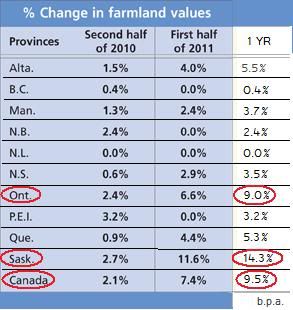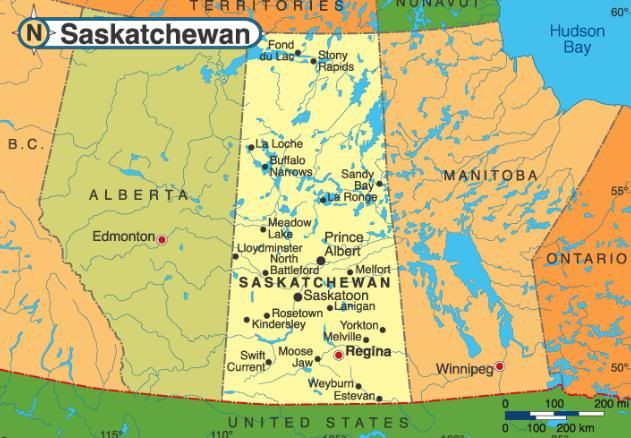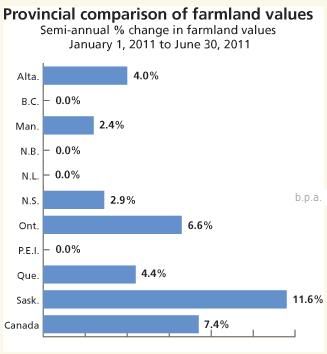
On average, Canadian farmland increased 7.4% in the first six months of 2011, and 9.5% for the year ending June 2011 according to Farm Credit Canada.

Saskatchewan farmland led the nation in farmland price increases, up 11.6% in six months ending in June, and up 14.3% for twelve months.
Why? According to Wikipedia:
Saskatchewan's economy is associated with agriculture; however, increasing diversification has meant that now agriculture, forestry, fishing, and hunting together make up only 6.8% of the province's GDP. Saskatchewan grows a large portion of Canada's grain. Wheat is the most familiar crop and the one most often associated with the province (there are sheafs of wheat depicted on the coat of arms of Saskatchewan), but other grains like canola, flax, rye, oats, peas, lentils, canary seed, and barley are also produced. Beef cattle production in the province is only exceeded by Alberta. Mining is also a major industry in the province, with Saskatchewan being the world's largest exporter of potash and uranium. In the northern part of the province, forestry is also a significant industry.
Oil and natural gas production is also a very important part of Saskatchewan's economy, although the oil industry is larger. Only Alberta exceeds the province in overall oil production. Heavy crude is extracted in the Lloydminster-Kerrobert-Kindersley areas. Light crude is found in the Kindersley-Swift Current areas as well as the Weyburn-Estevan fields. Natural gas is found almost entirely in the western part of Saskatchewan, from the Primrose Lake area through Lloydminster, Unity, Kindersley, Leader, and around Maple Creek areas.

photo: wikipedia cc
Fields of canola and flax on the Saskatchewan Prairie.
The market for Saskatchewan's farmland was summarized by Farm Credit Canada like this:
Strong commodity and cattle prices were the primary reasons for the increase. It is becoming more common for owners to accept rental agreements on their land instead of selling. Demand significantly exceeded supply, as land in Saskatchewan is considered a safe investment and is currently providing a solid return. Interest rates also remained attractive.Since Farm Credit Canada doesn't report actual per acre prices, I googled around a bit and found southern Saskatchewan grain producing farmland to be in the $600-800 range, and as high as $1,100 per acre. If any reader here is knowledgeable about this region's going prices, please leave a comment.
The largest increases occurred in the northwest and southeast areas of the province, which experienced good crops and strong commodity prices in the fall of 2010. Factors impacting this increase included out-of-province farmers relocating to Saskatchewan to purchase competitively priced farmland, larger local producers expanding their land base, oil and gas influence (especially in the Bakken oilfield), and continued demand for heavy clay soils.
Following, is Farm Credit Canada's graphic showing average farmland price increases since 2006. Note that farmland prices across Canada vary widely.

Next, how the provinces compared to one another:
